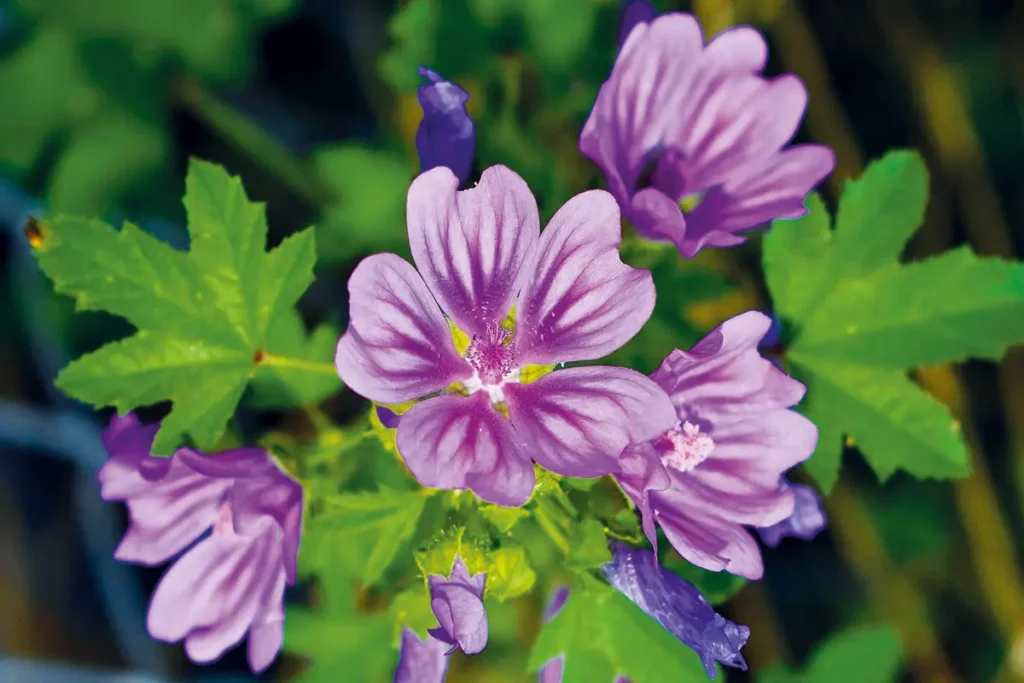


Nome Italiano: Malva
Nome scientifico: Malva sylvestris L.
Nome Gallurese: Palmuzza
Descrizione:
Pianta erbacea annuale, biennale o perenne. Ha un fusto eretto o prostrato che può crescere dai 60 agli 80 cm. Le foglie di forma palminervia dai 5 ai 7 lobi e margine seghettato irregolarmente. Fiori di colore rosa-lilla, sbocciano da maggio ad agosto. Il nome deriva dal verbo latino mollire che significa rendere morbido, in relazione alle sue proprietà emollienti e lenitive.
Proprietà e usi:
I principi attivi si trovano nei fiori e nelle foglie che sono ricchi di mucillagini; contiene anche potassio, ossalato di calcio e vitamine. In cucina si usano i germogli, i fiori freschi o le foglioline mischiati alla verdura, può regolare le funzioni intestinali stimolandone la contrazione. È una pianta assai utilizzata in erboristeria contro le infiammazioni delle mucose e le forme catarrali delle prime vie bronchiali; e anche lassativa, antiflogistica, emolliente e oftalmica. Per tali usi le foglie vengono preparate in decotto, affinché le mucillagini possano sciogliersi nell’acqua.
Curiosità e miti:
Il detto “la malva da ogni malattia salva” la dice tutta su quanto sia considerata questa pianta. Presenta la particolarità di avere un fiore che si muove seguendo il sole. Questo fenomeno si chiama eliotropismo. Nella nostra tradizione locale i fiori venivano raccolti alla vigilia di San Giovanni e collocati sui davanzali perché bevessero la rugiada per diventare così vera panacea per tutti i mali.
È una pianta caratterizzata da una forte vibrazione femminile, posta sotto l’influenza dei pianeti Luna e Venere. Nel Medioevo era considerata una pianta indispensabile nelle pozioni d’amore, ed era impiegata come antidoto calmante contro gli afrodisiaci. Colta nel momento giusto, è efficace per combattere le negatività. Chi opera in magia, infatti, beve spesso infusi di Malva per depurarsi dalle avversità.

Italian name: Malva
Scientific name: Malva sylvestris L.
Gallurese name: Palmuzza
Description:
Herbaceous annual, biennial or perennial plant. It has an erect or prostrate stem that can grow from 60 to 80 cm. The leaves are palmate with 5 to 7 lobes and irregularly serrated margin. Lilac-pink flowers bloom from May to August. The name is derived from the Latin verb mollire meaning to make soft, in connection with its emollient and soothing properties.
Properties and uses:
The active ingredients are found in the flowers and leaves, which are rich in mucilage; it also contains potassium, calcium oxalate and vitamins. The sprouts, fresh flowers or small leaves are used in cooking mixed with vegetables; it can regulate intestinal functions by stimulating their contraction. It is a plant widely used in herbal medicine against inflammation of the mucous membranes and catarrhal forms of the first bronchial tract; it is also laxative, antiphlogistic, emollient and ophthalmic. For these uses, the leaves are prepared as a decoction so that the mucilage can dissolve in water.
Curiosities and myths:
The saying ‘mallow saves from every disease’ says it all about how highly regarded this plant is. It has the particularity of having a flower that moves following the sun. This phenomenon is called heliotropism. In our local tradition, the flowers were picked on the eve of St John’s Day and placed on windowsills to drink the dew, thus becoming a true panacea for all ills.
It is a plant characterised by a strong feminine vibration, placed under the influence of the planets Moon and Venus. In the Middle Ages it was considered an indispensable plant in love potions, and was used as a soothing antidote to aphrodisiacs. Taken at the right time, it is effective in combating negativity. Those who work in magic often drink mallow infusions to cleanse themselves of adversity.
